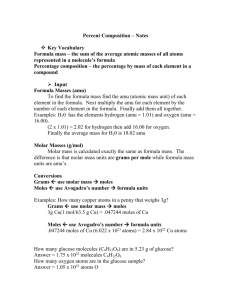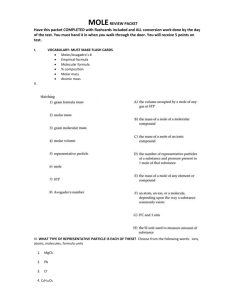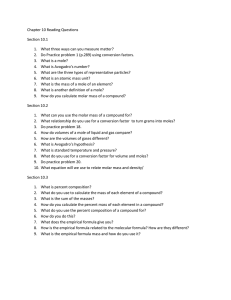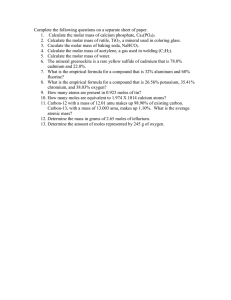1 Na atom
advertisement
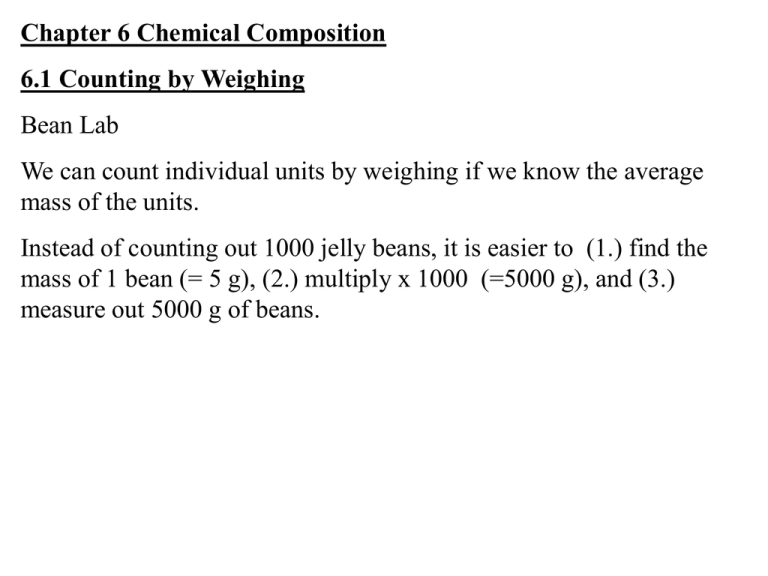
Chapter 6 Chemical Composition 6.1 Counting by Weighing Bean Lab We can count individual units by weighing if we know the average mass of the units. Instead of counting out 1000 jelly beans, it is easier to (1.) find the mass of 1 bean (= 5 g), (2.) multiply x 1000 (=5000 g), and (3.) measure out 5000 g of beans. 6.2 Atomic Masses: Counting Atoms by Weighing Pennium Lab When we know the average mass of the atoms of an element, we can calculate the number of atoms in any given sample of that element by weighing the sample. 1 amu = 1.66 x10-24 g Using Table 6.1, p. 157, calculate the mass, in amu of a sample of aluminum that contains 75 atoms. 1 Al atom = 26.98 amu mass of 75 atoms = 75 atoms x 26.98 amu = 2024 amu 1 atom Calculate the number of sodium atoms present in a sample that has a mass of 1172.49 amu, if 1 Na atom = 22.99 amu. 1172.49 amu x 1 Na atom = 51.00 Na atoms 22.99 amu 6.3 The Mole 1 dozen = 12 1 pair = 2 1 score = 20 1 mole = 6.02 x 1023 objects (a counting number, an exact number; infinite # of sig figs) aka Avogadro’s Number (p. 160) A sample of an element with a mass equal to that element’s average atomic mass expressed in grams contains 1 mole of atoms. Example: see Table 6.2, p. 160 Conversions: (p. 164) 5.00 x 1020 atoms Cr Determine # of moles: Determine mass, in grams: Mole Map Mass, in grams (use molar mass) Mole (use Avogadro’s #) Number of Atoms (use 22.4 L) Volume, in Liters (of a gas at STP, standard temperature, 0oC, and standard pressure, 1 atm) (Ch. 13 Gases) 6.4 Molar Mass Ionic compounds- calculate the mass of 1 formula unit of the compound (compound formula as written). For ex., NaCl molar mass = _________ CaCl2 molar mass = _________ For covalent compounds- calculate the mass of the molecule (compound formula as written). For ex., (p. 166, ex. 6.5) SO2 molar mass = 64.07 g C2H3Cl molar mass = _________ CuSO4 5H2O molar mass = _________ Conversions: mass from moles, p. 168 Moles from mass, p. 168 number of molecules (or formula units, if ionic) from mass, p. 169 6.5 Percent Composition of Compounds Percent (by mass) for a given element= mass of element x 100% mass of 1 mol of compound Example: MgCO3 molar mass = ____________ Example: penicillin, p. 173 6.6 Formulas of Compounds Empirical formula- lowest whole-number ratio of all elements in a compound formula. For ionic compounds, ALL formulas are empirical formulas. Molecular formula- for covalent compounds, the actual number of atoms of each type of element present in the compound. Ex.: C6H12O6 is molecular formula; CH2O is its empirical formula. 6.7 Calculation of Empirical Formulas How to find: 1. Find actual # of moles 2. Find relative # of moles (must be in whole numbers); divide actual # of moles of each element by the smallest. Sometimes you must then multiply by some integer to get everything in whole numbers (integers) representing a ratio. These integers are your subscripts. Example: p. 180 Example: p. 181 Example: p. 183 (using % composition)(assume 100 grams) 6.8 Calculation of Molecular Formulas (all steps are the same except for 1 additional step.) Check the molar mass of the empirical formula; if it is the same as the molecular mass given in the problem, then you are done. If not, you must find by what factor is it different. Then multiply the subscripts in the empirical formula by that factor. Example: p. 185
